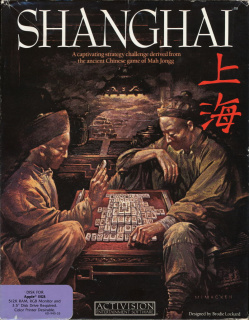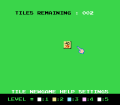Shanghai (video game)
| Shanghai | ||||||||||||||||
|
Apple IIgs - USA - 1st edition. |
||||||||||||||||
|
Shanghai is a mahjong solitaire puzzle video game developed by Brodie Lockard and published by Activision initially for the Macintosh Classic in July 1986, and then ported to 20 other platforms. This was the first commercial game in the Shanghai series, and the first video game to popularize mahjong solitaire in the West as it sold extremely well and resulted in a large number of sequels. The Lynx port is different enough to be treated as a different game.
The original Macintosh Classic version of Shanghai was made almost entirely by Brodie Lockard. He took his earlier game, Mah-Jongg for the PLATO, and ported it to the Macintosh in C. He updated his original art, but kept the derpy dragon. Activision bought the finished product and only modified some of the screens to put their brand on it. They also used a highly weighted contract cheating Lockard out of his copyright for the game. Because of this, all the other ports and sequels were made by various developers. The first couple ports used Lockard's thicker borders idea to simulate depth, but, after the Amiga port added a raised 3-D visual effect, Lockard updated the Macintosh version to include the effect, and subsequent ports also made use of the effect.
Contents
Personal
| Own? | No. |
|---|---|
| Won? | Yes. Most ports. |
| Finished | Master System: 2022-02-10 / Apple IIgs: 2022-02-11 / PC Engine: 2022-09-20 / Amstrad CPC: 2023-08-18 / Famicom: 2023-09-03 / Game Boy: 2023-12-28 / FDS (prototype): 2024-02-03 / MS-DOS: 2024-02-15 / TRS-80 CoCo: 2024-02-15 / Sharp X-1: 2024-02-15 / MSX2: 2024-02-16 / Amiga: 2024-02-27 / PC-8800: 2024-03-01 / PC-9800: 2024-03-01 / Apple II: 2024-03-04 / Atari 8-bit: 2024-03-07 / Atari ST: 2024-03-09 / Commodore 64: 2024-03-11 / Macintosh Classic: 2024-03-16 / FM Towns: 2024-03-17 / Sharp X68000: 2024-03-18. |
While perusing the Master System library, I saw this game. I knew it was a mahjong solitaire game and was curious to see what it had going for it and was a bit disappointed to discover it was just the basic game and nothing more. After I beat that port, I tried several other versions.
Review
| 3 | 4 | 4 | 4 | 6 |
Best Version: FM Towns
— This section contains spoilers! —
Good
- The game competently enforces the rules of mahjong solitaire.
- For the 16-bit ports, the graphics are attractive. For the some of the 8-bit ports, they're passable.
- Several of the ports have fitting Chinese-inspired music like those for the Master System, NES, PC Engine, and FM Towns.
- The better ports have enjoyable ending animations.
- Several later ports include a multi-player mode where each player has only a limited time to find a match.
Bad
- The game deals the tiles out randomly. While this is true to the original game, it results in a large percentage of games being impossible to win. Later adaptions take advantage of the using a computer to deal the tiles in matched pairs ensuring that every game is beatable (provided you make all the right moves).
- Some of the ports don't simulate the 3D raised effect of the tiles which makes them much harder to play (Atari 8-bit, Atari ST, Commodore 64, Macintosh, MS-DOS, NES, PCjr ports), while others do it very poorly (Apple II, Commodore 64). The Game Boy port simulates 3D, but the lack of color makes it harder to discern the pieces (it has an option for letters instead). Also, some ports have such a low resolution, the tiles are difficult to read.
- Only the NES and Game Boy ports have good music. Most don't feature background music while playing, a lot don't have music at all.
Ugly
- For nearly every port, the game is just the most basic possible version of mahjong solitaire. It has only the standard turtle layout with no other options. To make an American analogy, it would be like buying a solitaire game and having it only feature standard Klondike solitaire with no other different game styles or variations. This probably would have been acceptable in the West in 1986 when the game first came out since so few would have been familiar with mahjong solitaire, but, by the time the last ports came out in 1990, they should have expanded the game, especially since the superior hardware could handle far more multimedia.
- The MS-DOS and PCjr ports have really bad controls. They don't support a mouse, and, without a joystick, keyboard movement is painfully slow.
Media
Box Art
This box features two Chinese peasants playing mahjong solitaire, which is odd since it's a single-player game. At least it accurately depicts what the game will be like. It was used on most Western PCs: Apple II, Apple IIgs, Atari ST, Commodore 64, Macintosh Classic, MS-DOS, TRS-80 CoCo. This is my favorite art.
Documents
Screenshots
Graphics
Videos
Play Online
Apple IIgs, Amstrad CPC, Famicom, Game Boy (Japan), Game Boy (USA), Master System, MS-DOS, MSX2, PC Engine
Representation
| Strong female character? | Fail | There are no characters. |
|---|---|---|
| Bechdel test? | Fail | There are no characters. |
| Strong person of color character? | Fail | There are no characters. |
| Queer character? | Fail | There are no characters. |
Links
- Video Games
- 1986 Video Games
- Video games developed by Activision
- Video games published by Activision
- Amiga Games
- Amstrad CPC Games
- Apple II Games
- Apple IIgs Games
- Arcade Games
- Atari 8-bit Games
- Atari ST Games
- Commodore 64 Games
- DOS Games
- FM Towns Games
- Game Boy Games
- Macintosh Classic Games
- MSX2 Games
- NES Games
- PC-8800 Games
- PC-9800 Games
- Master System Games
- Sharp X1 Games
- Sharp X68000 Games
- TRS-80 Color Computer Games
- TurboGrafx-16 Games
- Video Game Genre - Cards
- Video Game Genre - Match-finding
- Video Game Genre - Passive puzzle
- Video Game Genre - Puzzle
- Video Game Genre - Single-screen
- Multiplayer
- Multiplayer Alternating versus
- Software Distribution Model - Commercial
- Video Games I Don't Own
- Video Games I've Beaten
- Video Game Rating - 3
- Video Game Graphics Rating - 4
- Video Game Sound Rating - 4
- Video games which can be played online
- Video games without a strong female character
- Video games that fail the Bechdel test
- Video games without a strong person of color character
- Video games without a queer character
- Video Game Prime Order - Strategy, Adventure, Action
- Card Games
- Monochrome Graphics
- 2-bit Color Graphics
- 4-bit Color Graphics



















